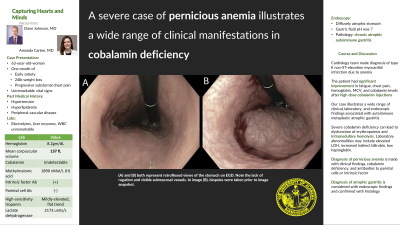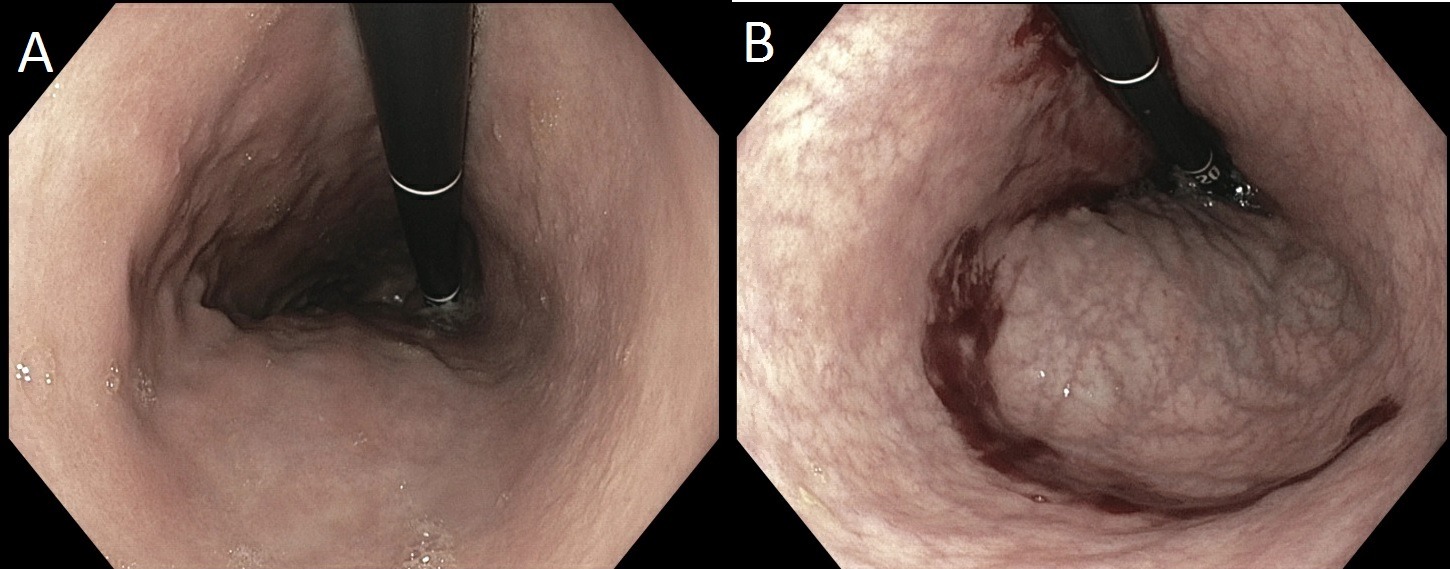Back


Poster Session B - Monday Morning
Category: Stomach
B0704 - Capturing Hearts and Minds: A Severe Case of Pernicious Anemia Illustrates a Wide Range of Clinical Manifestations in Cobalamin Deficiency
Monday, October 24, 2022
10:00 AM – 12:00 PM ET
Location: Crown Ballroom

Has Audio
- DJ
Dane T. Johnson, MD
University of Alabama at Birmingham
Birmingham, AL
Presenting Author(s)
Dane T. Johnson, MD, Amanda Cartee, MD
University of Alabama at Birmingham, Birmingham, AL
Introduction: Worldwide, pernicious anemia is the most common cause of cobalamin deficiency. Diagnosis of pernicious anemia is often delayed due to insidious onset and wide range of clinical presentations. Individuals may not develop symptomatic anemia for years due to slow progression of anemia and physiologic acclamation. Atypical presentations include neuropsychiatric manifestations without anemia, hemolytic anemia, normocytic anemia, or macrocytosis with normal cobalamin levels.
Case Description/Methods: We present the case of a 63-year-old woman with known hypertension, hyperlipidemia, peripheral arterial disease who presented to the emergency department for 1 month of early satiety, 24 pound weight loss, and substernal chest pain. Physical exam and vital signs were unremarkable. Initial laboratory evaluation was notable for normal electrolytes, normal liver enzymes, elevated LDH 2173 units/L, mildly elevated high-sensitivity troponin, undetectable cobalamin level, normal folate level, white blood cell count 4.71, hemoglobin 8.2 g/dL, MCV 137 fL, and platelets 430. Subsequent labs included normal ferritin, methylmalonic acid of 1890 nMol/L, serum gastrin 338 pg/dL, positive intrinsic factor antibodies, and undetectable parietal cell antibodies. Esophagogastroduodenoscopy performed the next day was notable for diffusely atrophic stomach. The pH of the aspirated fluid was 7. Pathology was notable for chronic gastritis consistent with atrophic autoimmune gastritis. Her evaluation was consistent with pernicious anemia and autoimmune gastritis, and she was started on high-dose cyanocobalamin injections. She had significant improvements in fatigue and chest pain within 1 week, and hemoglobin, MCV, B12 levels normalized within 2 months.
Discussion: Our case illustrates the wide range of clinical, laboratory, endoscopic findings associated with autoimmune metaplastic atrophic gastritis. Individuals with anemia can present with signs of end organ ischemia. Our patient presented with chest pain and laboratory evidence consistent with non-ST segment myocardial infarction. In addition, labs may show increased lactate dehydrogenase, increased indirect bilirubin, and decreased haptoglobin due to erythropoiesis dysfunction and subsequent intramedullary hemolysis. The diagnosis of atrophic gastritis is confirmed with endoscopic findings and histology. Diagnosis of pernicious anemia is made with combination of clinical findings, cobalamin deficiency, and antibodies to parietal cells or intrinsic factor.

Disclosures:
Dane T. Johnson, MD, Amanda Cartee, MD. B0704 - Capturing Hearts and Minds: A Severe Case of Pernicious Anemia Illustrates a Wide Range of Clinical Manifestations in Cobalamin Deficiency, ACG 2022 Annual Scientific Meeting Abstracts. Charlotte, NC: American College of Gastroenterology.
University of Alabama at Birmingham, Birmingham, AL
Introduction: Worldwide, pernicious anemia is the most common cause of cobalamin deficiency. Diagnosis of pernicious anemia is often delayed due to insidious onset and wide range of clinical presentations. Individuals may not develop symptomatic anemia for years due to slow progression of anemia and physiologic acclamation. Atypical presentations include neuropsychiatric manifestations without anemia, hemolytic anemia, normocytic anemia, or macrocytosis with normal cobalamin levels.
Case Description/Methods: We present the case of a 63-year-old woman with known hypertension, hyperlipidemia, peripheral arterial disease who presented to the emergency department for 1 month of early satiety, 24 pound weight loss, and substernal chest pain. Physical exam and vital signs were unremarkable. Initial laboratory evaluation was notable for normal electrolytes, normal liver enzymes, elevated LDH 2173 units/L, mildly elevated high-sensitivity troponin, undetectable cobalamin level, normal folate level, white blood cell count 4.71, hemoglobin 8.2 g/dL, MCV 137 fL, and platelets 430. Subsequent labs included normal ferritin, methylmalonic acid of 1890 nMol/L, serum gastrin 338 pg/dL, positive intrinsic factor antibodies, and undetectable parietal cell antibodies. Esophagogastroduodenoscopy performed the next day was notable for diffusely atrophic stomach. The pH of the aspirated fluid was 7. Pathology was notable for chronic gastritis consistent with atrophic autoimmune gastritis. Her evaluation was consistent with pernicious anemia and autoimmune gastritis, and she was started on high-dose cyanocobalamin injections. She had significant improvements in fatigue and chest pain within 1 week, and hemoglobin, MCV, B12 levels normalized within 2 months.
Discussion: Our case illustrates the wide range of clinical, laboratory, endoscopic findings associated with autoimmune metaplastic atrophic gastritis. Individuals with anemia can present with signs of end organ ischemia. Our patient presented with chest pain and laboratory evidence consistent with non-ST segment myocardial infarction. In addition, labs may show increased lactate dehydrogenase, increased indirect bilirubin, and decreased haptoglobin due to erythropoiesis dysfunction and subsequent intramedullary hemolysis. The diagnosis of atrophic gastritis is confirmed with endoscopic findings and histology. Diagnosis of pernicious anemia is made with combination of clinical findings, cobalamin deficiency, and antibodies to parietal cells or intrinsic factor.

Figure: (A) and (B) both represent retroflexed views of the stomach on EGD. Note the lack of rugation and visible sumucosal vessels. In image (B), boipsies were taken prior to image snapshot.
Disclosures:
Dane Johnson indicated no relevant financial relationships.
Amanda Cartee: Alimentiv, Inc – Advisory Committee/Board Member. Equillium, Inc – Consultant.
Dane T. Johnson, MD, Amanda Cartee, MD. B0704 - Capturing Hearts and Minds: A Severe Case of Pernicious Anemia Illustrates a Wide Range of Clinical Manifestations in Cobalamin Deficiency, ACG 2022 Annual Scientific Meeting Abstracts. Charlotte, NC: American College of Gastroenterology.
